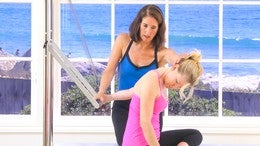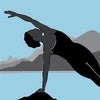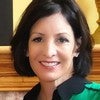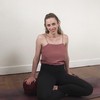Description
In her book Centered, Madeline offers an interdisciplinary approach to physical training, combining the newest advances in science, and integrating the movement systems of Pilates, Yoga, Gyrotonic®, and other fitness disciplines. Centered clearly describes the complex connections of the musculature, fascia, and joints and their implications for movement re-education and healing. It weaves science and philosophy, bringing meaning to function versus structure and body dysfunction.
This richly illustrated book offers Pilates instructors the knowledge to advance their work to become movement practitioners, learning to fully grasp biomechanics and information on posture and its dysfunction in order to sufficiently implement lasting changes for clients.
To purchase this book, you can go to Madeline's website or to the publisher's site.
About This Video
Transcript
Read Full Transcript
Madeline black has distinguished herself as an international leader in movement and exercise education. She's been a continual source of inspiration and education for the Politesse community for over 25 years. Madeline is a teacher's teacher and always a student. She's known in our field as a master of synthesizer, integrating movement science, osteopathic theory, manual therapy and energy work, creating an innovative interdisciplinary approach to [inaudible] Yoga and Gyrotonic. She coaches the most advanced teachers and now she can add author to her list of credentials as she has just completed her first book called centered organizing the body through kinesiology movement theory and [inaudible] techniques.
Madeline is here with us today to talk a little bit more about the book and how she thinks it will help politesse instructors become better teachers. Welcome and thank you for being here. Congratulations. I can't imagine. And my first question really is, uh, have you always wanted to write a book and had, how did it come to be that you did? I wanted to write a book, but a very different book. So it's interesting. I wanted to write a book more for clients, just ordinary person. Um, but I had the opportunity to write a more science-based book based on all the manuals that I've created for all the workshops after all these years. So when I've had so many workshops and rewriting and rewriting of manuals that I hand out, you know, as part of the workshops became an entire body.
So foot workshop, you know, breathing workshop, shoulder workshop. So all of a sudden I had a whole body of workshops and manuals, so it made sense to try to really flush it out and expand it into one book. Tell us about the title. Does that reflect what you're, what you just said? The title was um, interesting how titles are tough, you know, to come up with. Um, and I was speaking with one of my, um, fellow teachers who's followed me over the years and she says, no one, you know, one word you always use is centered.
I hear you say that a lot. And I was like, hmm, yeah, I guess I do. So I knew I wanted a one word title. Um, but centered, what does that say? There's no word Caladrius in there. You know, it's in, it could be a meditation, you know. So I started playing with a subtitle, which became very, uh, difficult to figure out. But on the other word I keep using and what I'm really interested in is how people are organized in their bodies. What do you mean by that? Organizing meaning how your nervous system works and how you move and you know, somebody's a sloppy mover, you know, not conscious about moving and how their, you know, gait and their rotation and balance. Uh, so it's to me, we can organize our bodies just like we can organize our closet. Oh,
And sometimes we need a little help for sure. Right. And organizing. So when the help comes from the practitioner. So, even though I could be coaching you, you would just might need a little encouragement with your hands or the way the apparatuses, you know, set up, uh, in queuing and all of that to help people move better. So, so who then is the book for [inaudible]? It's primarily for Polaris teachers. Um, because that's my lineage is where it comes from. But since I've evolved out into movement science, it's very applicable to anyone who teach us movement. Um, Yoga, Gyrotonic, um, personal trainers. I put in a lot of anatomy, uh, anatomy in a more s uh, kind of global picture so that, you know, this has an effect on that and how the new fascia science has come into it.
Um, so any person, a teacher who was interested in learning more about movement and about integrity of the tissue and um, and the hands on skills and exercises, non apparatus based is very applicable, again to other movement teachers. I also think clients may like to look at the book. It's pretty advanced in terms of the anatomy information. Uh, but I have people, clients who, uh, really enjoy learning about their body. And there are there, uh, for instance, like the neck chapter I think is one of the strongest chapters in terms of having clients read. Um, because I give a lot of like home program, hands on to yourself, uh, kinds of exercises. Um, what I noticed in the proof that I got to look at with, um, that I liked for me that the expectation for some of the exercises were that you did know polities. In other words, you're not teaching how to teach [inaudible] in this. And yet there was enough conceptually or without [inaudible] movements like hands on that that were would, if I weren't [inaudible] teacher that would help me in other modalities like yoga or Gyrotonic. Um, probably more than that actually. Um, so I liked, I really liked that approach and, and I liked the, the way you set it up and I, I know it was intentional in the three sections, can you just speak what the three sections are and how you made that decision?
Yeah. The three sections are lady, because for instance, the first section is the foot to the lower spine or to the spine, sole sole to spine. So the foot motion affects how the spines moving and how the spine is moving is also affecting the foot suit. So you can focus in on a foot, which I do do in chapter one, but there's a whole relationship to the pelvis and the spine and vice versa. So it made sense to me that one section should foot to the spine. Uh, and then the second section being our primary center. So that means the trunk, but it also means breathing stability core, you know, the whole trunk that way.
And then the third being more of the upper part of the shoulders, the neck, you know, and the head, uh, action. Yeah, it makes perfect sense from like a building blocker, even mechanistic kind of way. But then you do something I really like. And something that when I first started learning from you, I was surprised. And I'll just briefly say that I had the impression you were all science, which I think you can be, but you're not. And what you've included that I think is really different is, um, the sections on contemplate of awareness. And, and for me that's like, oh, there's that other piece of that she always adds, it's a little hard to put your finger on. Can you explain just what I'm talking about that the contemplate of awareness, what is that and why did you put them in?
It's important to me to understand when someone's having difficulty, even in just a normal movement pattern, you know, and the difficulty just being that they haven't been taught the motor control around that movement. And what is that in a deeper level, a meeting. Why, why do they have that block? Or why didn't they learn that? What's the missing link? Or I tried to help them change it and they can't seem to grasp that. So then I go to the next step of, you know, what is preventing them emotionally, you know, energetically what, what is that piece that someone's not kind of breaking through? And it's just an awareness of like metaphors to me about the body. You know, our whole body, the anatomy can be a metaphor. So when, you know, one of my favorites is the knee metaphor, meaning what is not allowing this person to step forward, right?
You need your knee to step forward in life, you know, and the metaphor around that. So it gives you, um, to me that part is really important cause it's just again, it's, it's an awareness and it's something to contemplate about. Yeah. So there actually little paragraphs that I didn't see the whole book but I got to see quite a bit and they seem to be in each chapter that I saw at the beginning. Okay. So I think, um, whether or not you ever teach to that, to open the door to even learn the science of it with that in mind, I think was a really nice addition. And I hope that, um, that people really pause there and do contemplate. So I thought that was cool. So what am I going to get from reading this book? Well, globally, I hope what people get from the book is a fuller understanding of not just anatomy, but actual dynamics of movement and the relation of the global parts with the local parts and with some heart to it. [inaudible] it's about relationships, isn't it? It is and isn't too.
Yes. Good. That's great. Well, something I think is really unique too is that you have video to go with it. That yes. And, and, and, and thank you. Oh yeah. It's a bit of a plug. I know, but it's, it's um, how lovely cause, um, just to explain what, what, what we're talking about is that we have videos that go with the chapters or maybe a couple of chapters that actually show that images in real life. So you're actually teaching to it. So, um, you don't need to take the workshop. Is that true? Correct. You could, they each stand on their own, but that if in they can be joined together for extra supplementation, is that correct? How it's planned? Yeah. That's great. I haven't seen it yet.
I can't wait. Yeah. When I was teaching, you know, I travel a lot in teach and so I've been promoting the book and then I say, oh, and there's video in the book. And then people look like, what does that mean? And then I say, well you, you're going to scan, you know, QR Code and you will go to pilates anytime site and it's going to come up and you'll get to watch the technique. With me being very specific, it's very hard to write in words. Exactly. Put your right hand here, move in this direction when you're reading words. So to be able to actually see it, you know, and a lot of teachers are our movers, you know, and visual also from seeing, you know, the reading, you know, so it's a, it's a fantastic, uh, addition to the book, which is new and you know, so it's very exciting. That's really exciting. I was, we were glad to be a part of that for sure. How can they stand alone and not that we want them to necessarily, but how does the workshop just go into talking about the techniques? Do you, um, is there any difference if they, if people didn't do both? Yeah, the workshop is similar to the book where it's divided in the three sections and then it's individual, um, techniques, but it's not just, Oh, here's a technique.
I actually explore the movement. Like for instance, in the foot, I go through a lot of detail of pointing to the bones and talking about it and the emotion. And then we looked at someone's foot and then we were watching. And so I'm teaching about that. And you can't put all those words in the book. Oh, I see. That's, you know, it's a little different in that way. And then to actually see the technique that's in the book, right. So it's a little, it's a little more expanded cause I'm just like teaching a workshop in that one particular section, like the foot. Uh, and then I've also added some techniques that are not in the book.
So if you are in the workshop, uh, on the website as a whole workshop, there's additional, uh, exercises and techniques that I had put in that I didn't put in the book, I think is, does that mean there's going to be a second book? I don't know. Listen, I'm just getting over the first one. Where will we find it? We can go to my website [inaudible] angle and black.com and I'll be setting up a po. Um, if you order the book through my website, I'll actually sign the book and send it. Um, I think can go to a handspring publishers website. They say sell it through there. Probably Amazon. I think I remember you saying you wanted to write a different kind of book altogether at one point. Yeah, I think he even started that true. Yes, I did.
Um, wait. So more on the side of a novel or a Yes. Right. I still have that one. It's sitting in my file and, and, and what I'm seeing, what I'm starting to see to come up coming out on the market now in the bookstores, I'm like, oh my God, it's timely for this book. So I am kind of thinking maybe I'm gonna bring that one back. Madeline black novelist tier, we're going to add that to [inaudible]. Good. So you're not turned off to writing altogether? You know, I'm not, the process is, is difficult. I mean, it's, I didn't know what I was getting into. So now I know.
How long have you taken you? I, I'm still gonna say three years because the first year was the more of the, um, proposal. So it took a year for the proposal. There's a lot of information you have to gather and, and, uh, so probably by the time I started writing the proposal and actually submitted it and got the yes, was a year and then two years, uh, with the bucket stuff. Yeah. Well, best of luck. Thank you. Congratulations.
Comments
Barbara ~ I'm sorry you are having trouble with the QR codes. Once you have access to the workshop, you should be able to stream each chapter either by scanning the QR code, or going directly to the workshop to watch it. Our downloading feature is not available for workshops with chapters right now, so you will only be able to stream it with an internet connection. Please email us at support@pilatesanytime.com if you have any questions.
You need to be a subscriber to post a comment.
Please Log In or Create an Account to start your free trial.
















